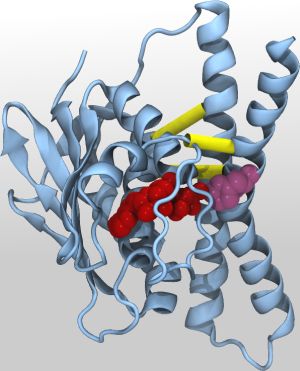Proteins control many processes in the body. Doing this, they change their structure. The activated structure, however, can hardly be accessed experimentally. Using genome analysis, computer simulations, and laboratory experiments, a team of international researchers has now developed a first model of the activated sensor histidine kinase, a signal transmission protein. Dr. Alexander Schug of Karlsruhe Institute of Technology (KIT) modeled the activation by extensive computer simulations. The results are presented in the Proceedings of the National Academy of Sciences of the United States of America (PNAS). The method may also be transferred to other proteins.
Proteins make up the molecular machinery of the body and fulfill a variety of tasks. As structure proteins, they are involved in the generation of tissue. As functional proteins, they are responsible among others for controlling metabolism, for mass transfer, blood coagulation, and immune defense. While proteins fulfill their functions, they often change their structure. This activated structure frequently is rather short-lived and, hence, can hardly be accessed experimentally. To understand and specifically influence the function of a protein e.g. when treating diseases with medicine, it is required to know the structural modifications in detail.
In a project combining genome analysis, computer simulation, and genetic engineering experiments, researchers from the USA, France, and Germany have developed a structural model of a hardly accessible activated structure of a major protein. Computer simulation and structure modeling were made by Dr. Alexander Schug, Head of the Helmholtz Junior Research Group “Multiscale Biomolecular Simulation” at the Steinbuch Centre for Computing (SCC) of KIT. The results are now presented in the journal PNAS.
The scientists concentrated on two-component signal transmission systems that frequently exist in bacteria. Such systems consist of a sensor histidine kinase protein that receives signals from outside and initiates information transmission by a so-called autophosphorylation and a response regulator protein. Only little structural information has been available about these systems so far.
By means of a statistical analysis of a large amount of genome data, the researchers identified parts of the sensor histidine kinase protein that interact with other during the structure modifications or disrupt their contacts. Based on this analysis, the KIT researcher Dr. Alexander Schug succeeded in modeling structure modifications during autophosporylation by extensive computer simulations and in generating a model of the activated structure. This model was then verified by laboratory experiments.
Two-component systems represent the primary signal-reaction system in all bacteria. Hence, the results obtained by the researchers contribute to understanding bacterial signal transmission. Based on their findings, it may be possible in the future to develop new antibiotics. Moreover, the approach is of relevance to other protein systems: “The volume of genome data exploded in the past ten years and will continue to grow rapidly. Our method can be transferred to more proteins assuming functions other than signal transmission,” explains Schug.
Angel E. Dago, Alexander Schug, Andrea Procaccini, James A. Hoch, Martin Weigt, and Hendrik Szurmant: The Structural Basis of Histidine Kinase Autophosphorylation. Integrating Genomics, Molecular Dynamics and Mutagenesis. In: PNAS – Proceedings of the National Academy of Sciences of the United States of America. June 5, 2012 (DOI:10.1073/pnas.1201301109).
For the online version of the article, click: www.pnas.org/cgi/doi/10.1073/pnas.1201301109.
In close partnership with society, KIT develops solutions for urgent challenges – from climate change, energy transition and sustainable use of natural resources to artificial intelligence, sovereignty and an aging population. As The University in the Helmholtz Association, KIT unites scientific excellence from insight to application-driven research under one roof – and is thus in a unique position to drive this transformation. As a University of Excellence, KIT offers its more than 10,000 employees and 22,800 students outstanding opportunities to shape a sustainable and resilient future. KIT – Science for Impact.

